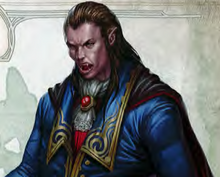- For the games by White Wolf Publishing, see Vampire: The Masquerade and Vampire: The Requiem.

A vampire from Dungeons & Dragons 5th edition.
A vampire, sometimes spelled vampyre, is a monstrous creature (often an undead human or humanoid) who feeds on the blood or other vital essence of a person.
Dungeons & Dragons[]
In the Dungeons & Dragons fantasy role-playing game, the vampire is an undead creature. A humanoid or monstrous humanoid creature can become a vampire, and looks as it did in life, with pale skin, haunting red eyes, and a feral cast to its features. A new vampire is created when another vampire drains the life out of a living creature. Its depiction is related to those in 1930s and 1940s Hollywood Dracula and monster movies.[1] In writing vampires into the game, as with other creatures arising in folklore, the authors had to consider what elements arising in more recent popular culture should be incorporated into their description and characteristics.[2]
The vampire was one of the first monsters introduced in the earliest edition of the game, in the Dungeons & Dragons "white box" set (1974), where they were described simply as powerful undead. They appeared again in the Greyhawk supplement. The vampire later appeared in the first edition Monster Manual (1977), where its description was changed somewhat to a chaotic evil, night-prowling creature whose powerful negative force drains life energy from victims.
One popular Dungeons & Dragons campaign setting, Ravenloft, has as a central character a vampire named Strahd von Zarovich, who is both ruler and prisoner of his own personal domain of Barovia. How Count Von Zarovich became the darklord of Barovia was detailed in the novel, I, Strahd: The Memoirs of a Vampire.[3]
White Wolf[]
In certain games published by White Wolf Publishing, most notably Vampire: The Masquerade and Vampire: The Requiem, all player characters are vampires who must fight to maintain their humanity (that is, their morality) despite being cut off from other humans, needing to drink the blood of the living to survive and being afflicted with a literally monstrous rage.
These games, especially Vampire: The Masquerade which came first, have been influential upon modern vampire fiction and elements of its terminology, such as embrace and sire, appear in contemporary fiction.[4]
Other role-playing games[]
GURPS Cabal, a book that features a customizable campaign setting for GURPS, depicts a modern-day secret society composed of vampires, lycanthropes and sorcerers who study the underlying principles of magic and visit other planes of existence and was integrated into Infinite Worlds, the "default" (core) setting for GURPS's 4th Edition. The Third Edition GURPS supplement Blood Types lists 47 different "species" of vampires describing 30 of them from both folklore and fiction in 23 listings (several are simply different names for the same type of vampire; for example the Burma's Kephn is considered a male version of the Penanggalen).
Shadowrun features vampires whose existence is explained by a resurgence of the Human Meta-Human Vampiric Virus. As such, the afflicted are not undead, but instead are still alive but radically changed by the retrovirus. They normally do not suffer from the supernatural limitations such as crosses, but still are vulnerable to sunlight.
In Torg, vampyres are from the realm of Orrorsh.
References[]
- ↑ (2014). The Ashgate Encyclopedia of Literary and Cinematic Monsters: 192–193. Ashgate Publishing
- ↑ James Grebey (June 3, 2019). "How Dungeons and Dragons reimagines and customizes iconic folklore monsters". SyfyWire.
- ↑ Gideon Kibblewhite (December 1995). "The Great Library". Arcane (1): 80. Future Publishing
- ↑ A. Asbjørn Jøn (2001). "From Nosteratu to Von Carstein: shifts in the portrayal of vampires". Australian Folklore: A Yearly Journal of Folklore Studies (16): 97–106
External links[]
- Vampires in games at Wikipedia, the free encyclopedia.
- Vampire (Dungeons & Dragons) at Wikipedia, the free encyclopedia.
